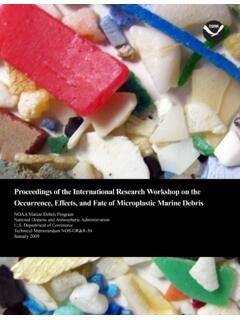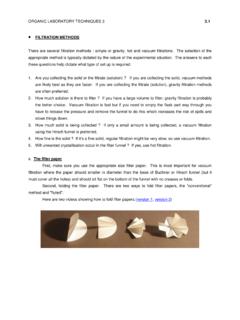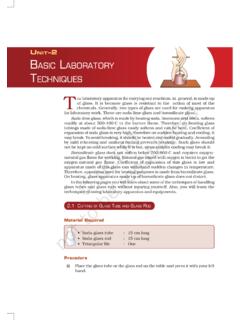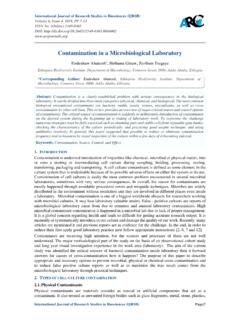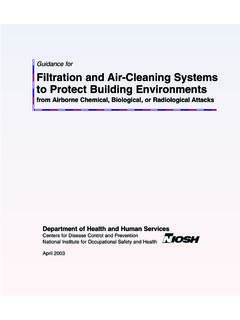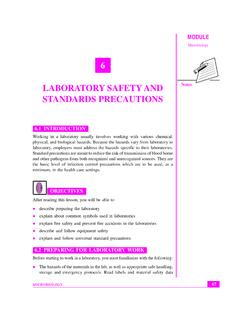Transcription of Laboratory Methods for the Analysis of Microplastics in ...
1 Photo credit: NOAA Marine Debris Program Laboratory Methods for the Analysis of Microplastics in the Marine Environment: Recommendations for quantifying synthetic particles in waters and sediments NOAA Marine Debris Program National Oceanic and Atmospheric Administration Department of Commerce Technical Memorandum NOS-OR&R-48. July 2015. Mention of trade names or commercial products does not constitute endorsement or recommendation for their use by the United States government. Laboratory Methods for the Analysis of Microplastics in the Marine Environment Recommendations for quantifying synthetic particles in waters and sediments Julie Masura1, Joel Baker1, Gregory Foster2, and Courtney Arthur3,4. Carlie Herring, Technical Editor3,4. 1. Center for Urban Waters, University of Washington, Tacoma WA. 2. Department of Chemistry and Biochemistry, George Mason University, Fairfax VA. 3. Systems Group, Rockville MD. 4. National Oceanic and Atmospheric Administration, Marine Debris Division, Silver Spring MD.
2 The suggested citation for this document is: Masura, J., et al. 2015. Laboratory Methods for the Analysis of Microplastics in the marine environment: recommendations for quantifying synthetic particles in waters and sediments. NOAA Technical Memorandum NOS-OR&R-48. For copies of this document, please contact: NOAA Marine Debris Division 1305 East-West Highway Silver Spring, MD 20910 USA. Acknowledgements The NOAA Marine Debris Program would like to acknowledge Sherry Lippiatt, Sarah Opfer Lowe, and Nir Barnea (NOAA National Ocean Service, Marine Debris Program) for reviewing this manual and providing helpful comments and Asma Mahdi for design and layout. Funding for this project was provided by the NOAA Marine Debris Program. This publication does not constitute an endorsement of any commercial product or intend to be an opinion beyond scientific or other results obtained by the National Oceanic and Atmospheric Administration. No reference shall be made to NOAA, or this publication furnished by NOAA, to any advertising or sales promotion which would indicate or imply that NOAA recommends or endorses any proprietary product mentioned herein, or which has as its purpose an interest to cause the advertised product to be used or purchased because of this publication.
3 Although released by NOAA, the information in this paper does not reflect, represent, or form any part of the support of the policies of NOAA or the Department of Commerce. i|Page Laboratory Methods for the Analysis of Microplastics Table of Contents Acknowledgements ..i Abbreviations ..iii Microplastics Background .. 1. Introduction to Methods Manual .. 2. Methods for the Analysis of Microplastics in Water Samples .. 3. Apparatus and Materials .. 7. Wet 8. Transfer Sieved 8. Determine the Mass of Total Solids .. 8. Wet Peroxide Oxidation (WPO).. 9. Density 10. Microscope 11. Gravimetric Analysis ..12. Methods for the Analysis of Microplastics in Beach 13. Apparatus and Materials ..15. Beach Sediment Sample Preparation ..16. Density Determine the Mass of Total Solids ..17. Wet Peroxide Oxidation (WPO)..18. Density 18. Microscope 19. Gravimetric Analysis ..19. Methods for the Analysis of Microplastics in Bed Samples .. 20. Apparatus and Materials.
4 22. Bed Sediment Sample Preparation .. 23. Wet Sieving and Transfer of Sieved Solids ..23. Determine the Mass of Total Solids (Sample Matrix)..23. Density Determine the Mass of Total Solids ( Microplastics and Natural Materials) ..24. Wet Peroxide Oxidation (WPO)..24. Density 25. Microscope 25. Gravimetric Analysis ..25. Cited 26. Appendices .. 27. Appendix of Calculations .. 27. Appendix of Guidelines and Considerations ..29. Note: All photos are credited to the University of Washington, Tacoma (with the exception of the cover photo to which the photo credit is the NOAA Marine Debris Program). ii | P a g e Laboratory Methods for the Analysis of Microplastics Abbreviations (aq) aqueous Fe(II) iron (II). NaCl sodium chloride (a salt). NOAA National Oceanic and Atmospheric Administration NOS National Ocean Service OR&R NOAA Office of Response and Restoration PVC polyvinylchloride WPO* wet peroxide oxidation 40X magnification with light microscopy by 40 times Units C Celsius d density g gram h hour in inch M Molar mg milligram mL milliliter mm millimeter min minute *The Wet Peroxide Oxidation (WPO) process results in a highly reactive mixture.
5 Please review your Laboratory safety practices and policies before completing this Analysis . In this manual, we have highlighted the WPO steps with a CAUTION note. iii | P a g e Laboratory Methods for the Analysis of Microplastics Microplastics Background Over the past decade, microplastic debris in both marine and freshwater systems has become an emerging issue. There is an increased interest to understand the impacts of Microplastics on aquatic wildlife, as the impacts still remain poorly understood (Thompson et al. 2004, Browne et al. 2007). Microplastics were first noted in North America as spherules in plankton tows along the coast of New England in the 1970s (Carpenter et al. 1972). Since then, Microplastics have been found in most large bodies of water (oceans, seas, lakes, and rivers). Microplastics are plastic particles smaller than mm in size (Arthur et al. 2009). The lower bound (size) of the Microplastics is not defined; however, it is common practice to use the mesh size (333 m or ) of the neuston nets used to collect the samples (Arthur et al.)
6 2009). There are two main ways Microplastics are formed and enter a body of water: primary and secondary Microplastics (Arthur et al. 2009). Primary Microplastics consist of manufactured raw plastic material, such as virgin plastic pellets, scrubbers, and microbeads (Browne et al. 2007, Arthur et al. 2009) that enter the ocean via runoff from land (Andrady 2011). Secondary microplastic introductions occur when larger plastic items (meso- and macro- plastics) enter a beach or ocean and undergo mechanical, photo (oxidative) and/ or biological degradation (Thompson et al. 2004, Browne et al. 2007, Cooper and Corcoran 2010, Andrady 2011). This degradation breaks the larger pieces into progressively smaller plastic fragments which eventually become undetectable to the naked eye. There are many uses for Microplastics . For example, microbeads are used in personal care products such as exfoliants in face scrubs. Microplastics are also used to deliver drugs in some medical applications (Browne et al.
7 2007). Further, fibers that shed from synthetic clothing and rope are Microplastics (Thompson et al. 2004, Browne et al. 2007), as are particles used in media blasting processes to clean boat hulls and large machinery (Browne et al. 2007). Many of these Microplastics , microbeads, and fibers are small enough to pass through wastewater treatment plants and enter a watershed (Browne et al. 2007). Impacts of Microplastics on wildlife are not well understood at this time. However, a number of organisms, both vertebrates and invertebrates have been found to ingest Microplastics . These examples represent numerous organisms with differing feeding mechanisms, including detritivores, deposit feeders, and filter feeders. Examples include scleractinian corals (Hall et al. 2015), mussels (Mytilus edulis; Browne et al. 2007), fish (Carpenter et al. 1972), as well as lugworms, amphipods, and barnacles (Thompson et al. 2004). Scientists are also concerned that organisms ingesting plastic debris may be exposed to contaminants sorbed to the plastic (Teuten et al.
8 2007). Plastic debris provides a sink and a source for chemical contaminants. Additives used in the manufacturing of plastics can leach from the plastics into the marine environment (Andrady 2011). On the other hand, hydrophobic contaminants present in the water may sorb to the plastic particles (Carpenter et al. 1972, Teuten et al. 2007, Andrady 2011). Thus, Microplastics may provide a mechanism to transport concentrated contaminants to organisms (Browne et al. 2007). 1|Page Laboratory Methods for the Analysis of Microplastics Introduction to Methods Manual This document is a Methods manual for measuring microplastic in the environment. This manual outlines step-by-step instructions for quantifying microplastic in marine environmental samples, including processes to streamline terminology and approaches. The Methods described here were determined after careful study and Laboratory work conducted through a grant from the NOAA Marine Debris Program to the University of Washington, Tacoma.
9 Project goals sought to streamline the terminology and techniques used to assess microplastic concentrations in marine environmental samples, and to develop Laboratory procedures to quantify microplastic particles in marine surface waters and bed sediments, as well as personal care products. An overarching aim was to provide scientists and educators with simple techniques that are reproducible and robust without requiring extensive equipment, and to describe a method that could be easily adopted by groups around the world. Depending on the study aims and environmental collection techniques, these techniques can be used to calculate concentrations of Microplastics using a variety of metrics, including per piece, per mass, or per volume. Considering metrics is important for comparing results with other researchers. For guidelines and considerations when conducting microplastic analyses, as well as calculations, see the appendices. 2|Page Laboratory Methods for the Analysis of Microplastics Methods for the Analysis of Microplastics in Water Samples This method can be used for the Analysis of plastic debris as suspended solids in water samples collected by a surface net.
10 Plastics include hard plastics, soft plastics ( foams), films, line, fibers, and sheets. The method involves the filtration of solids obtained in a mm surface sampling net ( a manta net for surface water tows) through and/or sieves to isolate the solid material of the appropriate size (Figures 1-4). The sieved material is dried to determine the solids mass in the sample. The solids are subjected to wet peroxide oxidation (WPO) in the presence of a Fe(II) catalyst to digest labile organic matter. The plastic debris remains unaltered. The WPO mixture is subjected to density separation in NaCl(aq) to isolate the plastic debris through flotation. The floating solids are separated from the denser undigested mineral components using a density separator. The floating plastic debris is collected in the density separator using a custom filter, air-dried, and plastic material is removed and weighed to determine the Microplastics concentration.

